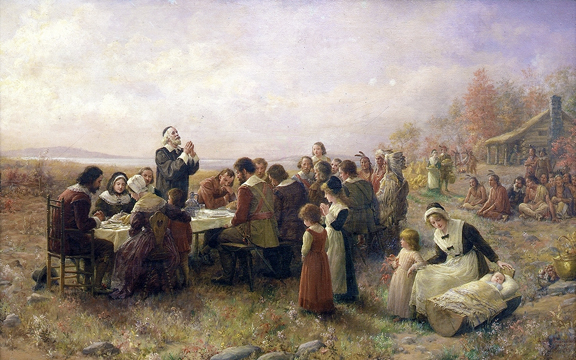 Today is Thanksgiving. If your family is like mine, there is a concerted
effort to get together today. We will eat the traditional food of the holiday –
turkey, mashed potatoes with gravy, stuffing, sweet potatoes and pumpkin pie
just like the Pilgrims did on the first Thanksgiving in 1621 with the friendly
Wampanoag tribe from Plymouth.
Today is Thanksgiving. If your family is like mine, there is a concerted
effort to get together today. We will eat the traditional food of the holiday –
turkey, mashed potatoes with gravy, stuffing, sweet potatoes and pumpkin pie
just like the Pilgrims did on the first Thanksgiving in 1621 with the friendly
Wampanoag tribe from Plymouth.
Actually, the first Thanksgiving table was not filled with the foods we
would call traditional fare. None of the foods I mentioned were present at that
meal. What did they eat? We are not completely sure of all the foods there, but
there are records showing they ate venison, fish (bass and cod), waterfowl and
cornbread. They also likely ate a variety of vegetables grown in the area
including squash, beans, carrots and onions. Some foods we associate with
Thanksgiving were used by the Native Americans, but not in the form we eat
them. Cranberries and pumpkins grow in that region, but in 1621, they did not
have sugar to sweeten them, so they likely ate them boiled or steamed with
other vegetables.
The fact is, the first Thanksgiving was very unlike our traditional
holiday setting, and that is more than just the food. The people who traveled
from England to Massachusetts were not really called Pilgrims. There were 102
passengers on the Mayflower. Of these, 41 were Christian separatists
that we typically call Pilgrims. They were Protestants who were looking for
religious freedom. They called themselves "Old Comers.” Ten years after
they arrived, William Bradford, Plymouth Colony’s second governor, wrote about
the Christian separatists who made the voyage in 1620 across the Atlantic,
calling them "saints and pilgrims.”Over the years, others began to
refer to them as Pilgrims. The word "pilgrim” means a wanderer. They had
wandered from their former home to forge a new life. That trip lasted 66 days
and was filled with rough waters and sickness in very close quarters. They
arrived in November 1620, just in time for winter to set in. Living on the ship
that winter, half of them did not survive. In the spring of 1621, the ship left
and they moved into the Plymouth colony.
They had to make do with what they had and that was not much. With the
help of the Wampanoags, they learned to fish and grow vegetables native to the
area. That included corn, beans and squash. When they harvested their crops in
the fall, they joined 91 Wampanoag men in a three-day celebration of thanks
that they had survived. Of the 102 people who left on the boat, only 52 were
still alive a year later. But this was more than just a time marking their
survival, it was a time of reflection on the goodness that had been granted
them. Together they had, by the grace of God, done what they set out to
do.
Today you might be like me. You will sit down to a traditional
Thanksgiving meal with your family without concern about whether there is
enough for everyone to eat today and tomorrow. Before you partake of that
Thanksgiving feast, take time to look around the table and think of the
goodness that has been granted to you. Give thanks for it.